| |
| |
Photographer,
Location |
Images |
Comments |
|
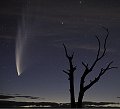
|
Peter Daalder,
Winkleig and Evandale, Tasmania, Australia
Jan. 22, 2007 |
#1,
#2 |
Photo
details: Canon
5D, 50mm
lens, f1.8, ISO 800, 10 seconds.
|
|
[movie]
|
Chris Picking,
Wairarapa, North Island, New Zealand
Jan. 23, 2007 |
#1,
more |
A short animated
sequence of the comet as it sets. These were taken over
a 25 minute period. Clouds move over the comet at the end
of the sequence.
Photo
details: Individual images were taken using a Canon
10D, 18mm
lens at f4.0, ISO800 and exposure times of 1 minute
each.
|
|
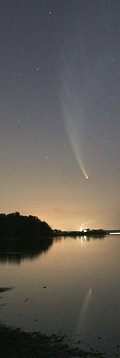
|
Chris Prior,
Swansea, on the shore of Lake Macquarie, NSW, Australia
Jan. 22, 2007 |
#1 |
The comet can
be seen reflected in the water.
Photo
details: Canon
20D, 18-55mm
lens, f5, 30 seconds, 800ISO
|
|
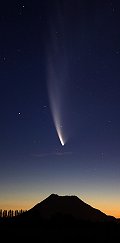
|
Jason Wright,
Eastern Bay of Plenty, New Zealand
Jan. 22, 2007 |
#1,
#2 |
My humble attempt
to do the magnificent sight of this comet justice. Framed
against Mt Putauaku in New Zealand's Eastern Bay of Plenty.
Photo
details: Canon
400D using a 17-55 mm f2.8 lens.
Prints
of the full 10 mp image available at a cost! ;)
|
|
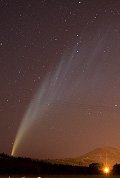
|
Peter Oliver,
Dunedin, New Zealand
Jan. 24, 2007 |
#1,
#2, more |
The comet is
visible all night long from my location so I was able to
shoot it at 2am with a dark sky.
Photo
details: Canon
350D, ISO 1600.
|
|
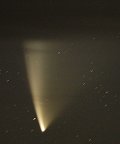
|
George Ionas,
Himatangi Beach, New Zealand.
Jan. 24, 2007 |
#1 |
Note that Comet
McNaught has developed a broad dust tail clearly visible
in binoculars.
Photo
details: Nikon
D100, Nikkor
105mm lens, f/1.8, 800 ISO, 30 sec exp.
|
|
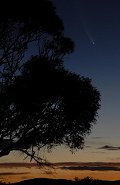
|
Ron Webb,
Jindabyne,New South Wales, Australia
Jan. 23, 2007 |
#1 |
Image taken
just after sunset with a eucalypt tree in foreground.
Photo
details: Nikon
D200 with 18/200 lens set at 82mm,f 6.3,5 sec, ISO 250
|
|
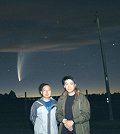
|
James Tse,
New Zealand, West Melton Observatory near Christchurch at South Island
Jan. 22, 2007 |
#1,
#2, #3,
#4, #5 |
The comet is
still bright enough to be visible by the naked eyes under
the clear and windy sky. Its tail spreads more than 10 degrees
bending like an arc.
Photo
details: Canon
350D, 800 ISO, Canon
16-35 mm lens, 70-200 mm EF lenses, Sigma
EX 8mm f/4 lens. Exposures 13s - 419s
|
|
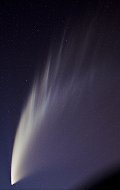
|
Dave Curtis,
Dunedin, New Zealand
Jan. 23, 2007 |
#1,
more |
Photo
details: Canon
1D Mrk2, 70-200mm
lens, f/2.8 IS 4 Stacked exposures ranging from 30 secs
to 4min. Camera was piggybacked on a tracking telescope:
Meade
LX200.
|
|
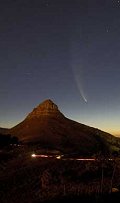
|
Andrew Ingram,
Cape Town, South Africa
Jan. 22, 2007 |
#1,
#2, #3,
more |
McNaught has
drawn a lot of attention from people not usually interested
in such things because it is simply so spectacular.
Photo
details: Nikon
D200 400 iso f2,8 8 seconds.
|
more
images: from
Robert Billing of Churchill, Victoria, Australia; from
H Teh on Mt Dandenong, Melbourne, Victoria, Australia; from
Elton Saheki of Pilar do Sul, SP, Brasil; from
Francisco Delgado of Puerto Varas, CHILE; from
Barry Kilner of Brighton , South Australia , Australia; from
Niels Endres of KooWeeRup, Victoria, Australia; from
Leigh Thomas of Warrnambool, Victoria, Australia;
from Dylan O of Albury, Australia;
|
|